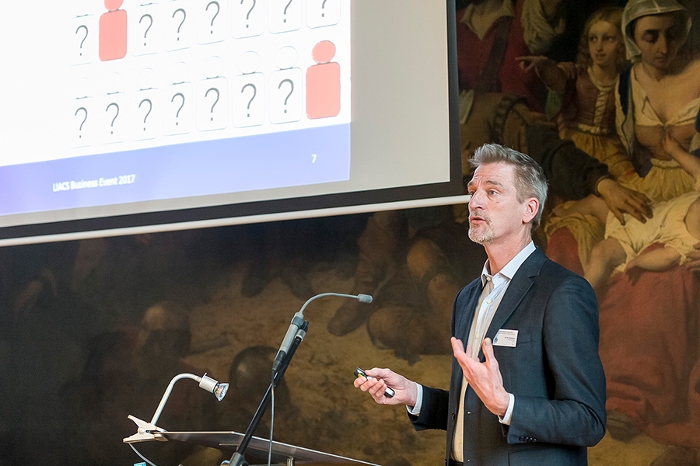
Unexpected data are good for business
Data play an important role in any organization. More and more data are available about products, about production processes and about customers. At the annual LIACS Business Event on Wednesday 18 January, the central message was how to find irregularities in Big Data, and how it can help you to track faults – and opportunities. Over 80 visitors heard how anomaly detection in data science can play a role in society. A report of the second Business Event of the computer science institute of Leiden University.
Cause of an anomaly
Thomas Bäck is a professor at the Leiden Institute of Advanced Computer Science (LIACS) and initiator of the meeting. ‘Many companies and governmental organizations gather lots of data. From experience we know that unexpected events hidden in the data stream hold important information for an organization. You are interested in finding the bumps of which you don’t really know a cause. Those bumps can influence your production processes, positively or negatively. So, you will have to find the cause of this anomaly.’
Detection of fraud and suspicious transactions
Wojtek Kowalczyk, data scientist at LIACS and the director of the Fraud Detection Expertise Center, first asks his audience to estimate the amount of money that is lost to fraud during this meeting alone. Rather surprised, he adds: ‘You are estimating this quite well with amounts between 1 and 50 million. I sometimes hear “A few thousand euros”. He then explains how he develops tools to detect fraud as early as possible. The Leiden data scientist Cor Veenman is working part time for the Netherlands Forensic Institute. ‘We work together with the police to find improbabilities in patterns. This way, we for example try to find suspicious transactions.’

Steel coils
Research partners from commercial organizations also give presentations. BMW and Tata Steel are using LIACS’ algorithms to detect anomalies in steel coils. ‘At this moment, we still analyze factors like the thickness of a coil, the amount of oil on a coil and the temperature manually’, says the German BMW expert Sebastian Kreissl. ‘They influence the quality of our product. Through data mining we can find anomalies automatically and give feedback to the experts directly.’
Identify anomalies in healthcare
LIACS also cooperates in research with Zorginstituut Nederland, a governmental organisation that advices about the costs of healthcare. Bert van Nistelrooij is a data scientist there. He explains that anomalies also occur in healthcare, but not all anomalies are reason to worry about your health.
No more trucks alongside the road
Mark van den Akker, CEO of Supergraph, a company that makes predicting models for clients, states that it is most important that theoretical findings are turned into decisions. ‘We for example are working with a transportation company that places chips into the tires of their trucks. With those, one can monitor the wearing rate of those tires and can predict when a tire will tear. So now the tire can be replaced before a truck is stuck alongside the road.’
Every business is data business
After the meeting, a plenary discussion and a drink give space to more exchange of thoughts with the audience. Initiator Thomas Bäck summarizes his opinion on the afternoon by saying: ‘Every business is data business. As anomalies in data become increasingly important, anomaly detection now is a key topic for industry and the public sector. I believe that became very clear from our business event.’

